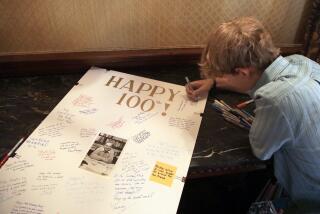Accidental Trip Led to a Lifetime Career : Science: Acclaimed Caltech professor who was recently honored by President Clinton got into aerodynamics after making a flip remark at a party.
- Share via
PASADENA — When the Liepmanns heard the explosion from the bedroom, they knew immediately what had happened. Their son, Hans, was experimenting again.
“But I removed the guinea pigs and mice first,” Hans Liepmann, now 79, remembers of the blast that blew a hole in the bedroom door. During his childhood in Berlin, his family could not afford a house and so his father, an obstetrician who experimented on animals, kept his laboratory specimens in the apartment’s one bedroom.
The grade-school boy was consequently forbidden to try to build rockets at home with magnesium powder, which was used for photography in the 1920s.
The man who once flunked Greek and wrestled with Latin at the University of Berlin received the National Medal of Technology from President Clinton on Sept. 30 at the White House. Liepmann was honored for lifetime achievement in teaching and research in aerodynamics and fluid mechanics.
He has worked and taught at Caltech 54 years, leading the first studies of high-speed aerodynamics. He also received the National Medal of Science in 1986, becoming the 11th person to win both awards.
His foray into aerodynamics, he says, was purely accidental.
Liepmann had earned doctoral degrees in physics and mathematics from the University of Zurich in 1938. At his Ph.D. party, his physics professor asked him what his plans were.
The young Liepmann, drunk and knowing nothing about the field, answered: “Aerodynamics.”
The professor, Edgar Meyer, told aeronautics pioneer Theodore von Karman, who invited Liepmann to come to Caltech. “I took to Caltech like a duck to water,” Liepmann said.
He worked first as a post-doctorate fellow at the Guggenheim Aeronautical Laboratories and rose to full professor by 1949. Liepmann taught Caltech’s first courses in high-speed aerodynamics. He also taught at the Douglas and Lockheed aircraft companies as the aviation industry grew during the 1940s, spurred by World War II.
The war, however, put German-born Liepmann in a strange position. “I drove the Pasadena police nuts,” he said, grinning. “I was an ‘enemy alien’ with secret clearance.”
The bespectacled professor, who still roams through the austere halls of Caltech’s labs with spry energy, has proved himself to be one of American technology’s assets in terms of teaching as well as research.
A poster on a stairwell wall shows a “family tree” of Ph.D.s in academic, industrial and executive fields, all taught by Liepmann.
“It was one of the best relationships in academia I ever had,” said Kaimo Hakkinen, who is a professor of fluid mechanics at Washington University in St. Louis. Hakkinen had Liepmann for a teacher and research head when he was at Caltech from 1949 to 1953. “He had a very strict scientific discipline and a wonderful sense of humor. . . . We felt we could talk with him about anything.”






